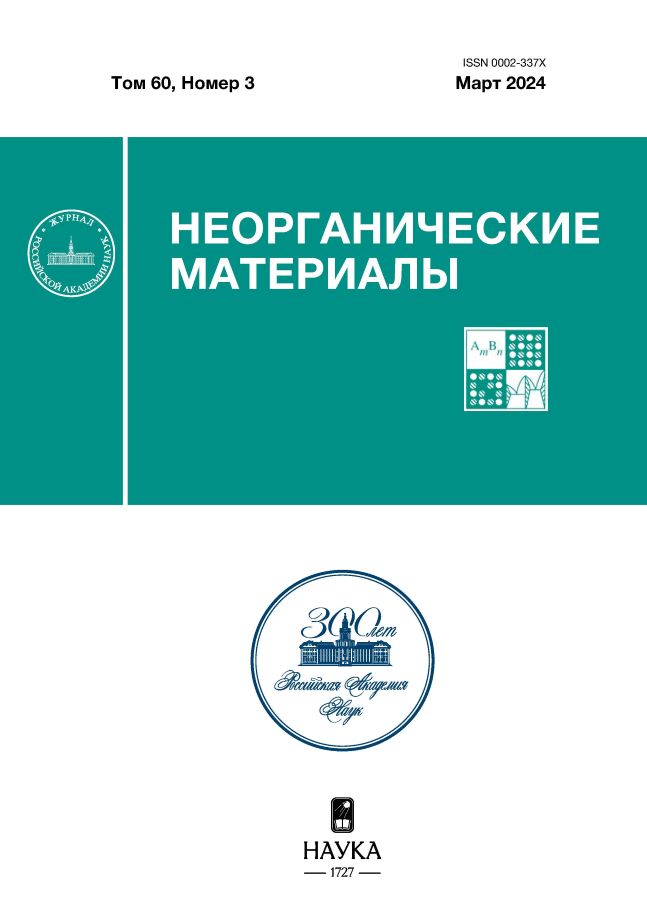Влияние спекающих добавок, синтезированных методом сжигания нитратов алюминия, на свойства керамики Al2O3–3YSZ
- 作者: Комоликов Ю.И.1, Ермакова Л.В.2, Журавлев В.Д.2, Сенаева Е.И.3, Шишкин Р.А.2
-
隶属关系:
- Институт физики металлов имени М.Н. Михеева УрО Российской академии наук
- Институт химии твердого тела УрО Российской академии наук
- Институт машиноведения УрО Российской академии наук
- 期: 卷 60, 编号 3 (2024)
- 页面: 373-380
- 栏目: Articles
- URL: https://cardiosomatics.ru/0002-337X/article/view/668518
- DOI: https://doi.org/10.31857/S0002337X24030152
- EDN: https://elibrary.ru/LJPJJI
- ID: 668518
如何引用文章
详细
Изучено влияние введения 15 мас. % спекающих добавок на твердость и пористость керамики Al2O3–3YSZ. Спекающую добавку в виде порошков α-Al2O3 синтезировали методом сжигания нитратов алюминия или Solution Combustion Synthesis (SCS) с использованием органических восстановителей глицина и мочевины. Замечено, что использование не разрушенных после SCS агрегатов субмикронных частиц оксида алюминия не позволяет получить высокоплотную керамику. После спекания при 1550°C керамические образцы имеют относительную плотность от 75 до 85% из-за значительной закрытой пористости. Значения микротвердости образцов варьируются от 1 до 11.1 МПа и коррелируют с изменениями плотности и пористости керамики. Для образца сравнения с добавкой оксида алюминия “ч.” достигнута максимальная относительная плотность 98% при отсутствии закрытой пористости.
全文:
作者简介
Ю. Комоликов
Институт физики металлов имени М.Н. Михеева УрО Российской академии наук
Email: larisaer@ihim.uran.ru
俄罗斯联邦, ул. С. Ковалевской, 18, Екатеринбург, 620108
Л. Ермакова
Институт химии твердого тела УрО Российской академии наук
编辑信件的主要联系方式.
Email: larisaer@ihim.uran.ru
俄罗斯联邦, ул. Первомайская, 91, Екатеринбург, 620108
В. Журавлев
Институт химии твердого тела УрО Российской академии наук
Email: larisaer@ihim.uran.ru
俄罗斯联邦, ул. Первомайская, 91, Екатеринбург, 620108
Е. Сенаева
Институт машиноведения УрО Российской академии наук
Email: larisaer@ihim.uran.ru
俄罗斯联邦, ул. Комсомольская, 34, Екатеринбург, 620049
Р. Шишкин
Институт химии твердого тела УрО Российской академии наук
Email: larisaer@ihim.uran.ru
俄罗斯联邦, ул. Первомайская, 91, Екатеринбург, 620108
参考
- Лукин Е.С., Макаров Н.А., Козлов А.И., Попова Н.А., Ануфриева Е.В., Вартанян М.А., Козлов И.А., Сафина М.Н., Лемешев Д.О., Горелик Е.И. Оксидная керамика нового поколения и области ее применения // Стекло и керамика. 2008. Т. 81. № 10. С.
- Carter C.B., Norton M.G. Ceramic Materials: Science and Engineering. N. Y.: Springer, 2007. https://link.springer.com/book/10.1007/978-1-4614-3523-5#book-header
- Абызов А.М. Оксид алюминия и алюмооксидная керамика (Обзор). Часть 2. Зарубежные производители алюмооксидной керамики. Технологии и исследования в области алюмооксидной керамики // Новые огнеупоры. 2019. Т. 2. С. 13–22. https://doi.org/10.17073/1683-4518-2019-2-13-22
- Bertrand S., Michalet T., Giraud A., Parlier M., Bataille A., Duclos R., Crampon J. Processing, Microstructure and Mechanical Strength of Reaction-Bonded Al2O3 Ceramics // Ceram. Int. 2003. V. 29. P. 735–744. https://doi.org/10.1016/S0272-8842(02)00225-0
- Turon-Vinas M., Roa J.J., Marro F.G., Anglada M. Mechanical Properties of 12Ce–ZrO2/3Y–ZrO2 Composites // Ceram. Int. 2015. V. 41. P. 14988–14997. https://doi.org/10.1016/j.ceramint.2015.08.044
- Thakare V. Progress in Synthesis and Applications of Zirconia // Int. J. Eng. Res. Dev. 2012. V. 5. P. 25. https://api.semanticscholar.org/CorpusID:14822500
- Heuer A.H. Transformation Toughening in ZrO2-Containing Ceramics // J. Am. Ceram. Soc. 1987. V. 70. P. 689–698. https://doi.org/10.1111/j.1151-2916.1987.tb04865.x
- Green D.J., Hanninck R.H., Swain M.V. Transformation Toughening of Ceramics. Boca Raton: CRC, 1989.
- Kelly P.M., Rose L.R.F. The Martensitic Transformation in Ceramics — Its Role in Transformation Toughening // Prog. Mater. Sci. 2002. V. 47. P. 462–557. https://doi.org/10.1016/S0079-6425(00)00005-0
- Lei J., Zhang Q., Wang Y., Zhang H. Direct Laser Melting of Al2O3 Ceramic Paste for Application in Ceramic Additive Manufacturing // Ceram. Int. 2022. V. 48. №10. P. 14273–14280. https://doi.org/10.1016/j.ceramint.2022.01.315
- Li J., Wang Q., Gai K., Lu B., Wu Y., Zheng K., Guan B., Han W., Ye L., Chen F., Zhao T. Zirconia-Alumina Multiphase Ceramic Fibers with Exceptional Thermal Stability by Melt-Spinning from Solid Ceramic Precursor // J. Eur. Ceram. Soc. 2022. V. 42. P. 7157–7165. https://doi.org/10.1016/j.jeurceramsoc.2022.08.036
- Boch Ph., Niepce J.C. Ceramic Materials: Processes, Properties and Applications. ISTE, 2007. 573p. ISBN: 978-0-470-61241-5. https://doi.org/10.1002/9780470612415
- Бурдыкин Д.А., Макаров Н.А., Артемкина И.М. Конструкционная керамика на основе системы ZrO2–Al2O3 с пониженной температурой спекания // Успехи в химии и хим. технологии. 2014. Т. XXVIII. № 8. C. 15–17.
- Zhang B., Wang C., Zhang Y., Zhang X., Yang J. A Novel Method for Fabricating Brick-Mortar Structured Alumina-Zirconia Ceramics with High Toughness // J. Eur. Ceram. Soc. 2023. V. 43. P. 727–732. https://doi.org/10.1016/j.jeurceramsoc.2022.10.013
- Cherif M., Duffarb T., Carroz L., Lhuissier P., Bautista-Quisbert E. On the Growth and Structure of Al2O3-Y3Al5O12-ZrO2:Y Solidified Eutectic // J. Eur. Ceram. Soc. 2020. V. 40. P. 3172–3180. https://doi.org/10.1016/j.jeurceramsoc.2020.03.025
- Xu X., Xu X., Liu J., Hong W., Du H., Hou F. Low-Temperature Fabrication of Al2O3-ZrO2 (Y2O3) Nanocomposites through Hot Pressing of Amorphous Powders // Ceram. Int. 2016. V. 42. P. 15065–15071. https://doi.org/10.1016/j.ceramint.2016.06.168
- Su H., Zhang J., Wang H., Song K., Liu L., Fu H. Effect of Solidification Path on the Microstructure of Al2O3–Y2O3–ZrO2 Ternary Oxide Eutectic Ceramic System // J. Eur. Ceram. Soc. 2012. V. 32. P. 3137–3142. https://doi.org/10.1016/j.jeurceramsoc.2012.03.027
- Zhuravlev V.D., Vasil’ev V.G., Vladimirova E.V., Shevchenko V.G., Grigorov I.G., Bamburov V.G., Beketov A.R., Baranov M. V. Glycine-Nitrate Combustion Synthesis of Finely Dispersed Alumina // Glass. Phys. Chem. 2010. V. 36. P. 506–512. https://doi.org/10.1134/S1087659610040164
- Zhuravlev V.D., Bamburov V.G., Beketov A.R. V.D., Perelyaeva L.A., Baklanova I.V., Sivtsova O.V., Vasil’ev V.G., Vladimirova E.V., Shevchenko V.G., Grigorov I.G. Solution Combustion Synthesis of α-Al2O3 Using Urea // Ceram. Int. 2013. V. 39. P. 1379–1384. https://doi.org/10.1016/j.ceramint.2012.07.078
- Khaliullin S.M., Nefedova K.V., Zhuravlev V.D. Nanocomposites mAl2O3–nYSZ by Impregnation Combustion Synthesis with Urea as a Fuel // Int. J Self-Propag. High-Temp. Synth. 2019. V. 28. P. 1–9. https://doi.org/10.3103/S1061386219010072
- Комоликов Ю.И., Кащеев И.Д. Высокопрочная керамика на основе порошка диоксида циркония // Стекло и керамика. 2002. Т. 75. № 6. С.
- Srdic V.V., Winterer M., Hahn H. Sintering Behavior of Nanocrystalline Zirconia Doped with Alumina Prepared by Chemical Vapor Synthesis // J. Am. Ceram. Soc. 2000. V. 83. P. 1853–1860. https://doi.org/10.1111/j.1151-2916.2000.tb01481.x
- Kong Y.M., Kim H.E., Kim H.W. Production of Aluminum–Zirconium Oxide Hybridized Nanopowder and Its Nanocomposite // J. Am. Ceram. Soc. 2007. V. 90. P. 298–302. https://doi.org/10.1111/j.1551-2916.2006.01353.x
- Rahaman M.N. Ceramic Processing and Sintering. 2nd ed. Boca Raton: CRC, 2017. Р.1–876 р. https://doi.org/10.1201/9781315274126
补充文件















